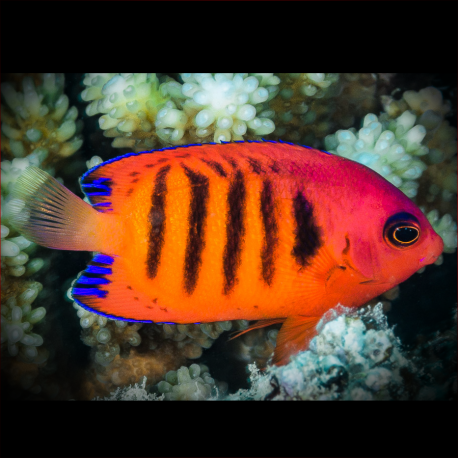More info
Datasheet
| Minimum Tank Size | 300 litres / 79.25 US gallons |
| Maximum Size | 12.0cm / 4.72inches |
| Reef Compatible | Reef safe with luck |
| Temperament | Might be aggressive towards similar species |
| Temperature | 22.2°C / 71.96°F - 25.6°C / 78.08°F |
| Specific Gravity | 1.020-1.025 |
| Carbonate Hardness | 8-12 |
| pH | 8.1-8.4 |
General Description
The Flame Angelfish, scientifically known as Centropyge loriculus, belongs to the Pomacanthidae family. These vibrant fish are renowned for their colorful appearance, making them popular choices for reef aquariums. Typically growing to around 10 cm, some specimens can reach up to 18 cm. Known for their striking hues, these Dwarf Angelfish species add a captivating allure to marine tanks, particularly due to their manageable size compared to other Angelfish varieties.
Aquarium Suitability
Considered suitable for aquariums, the Flame Angelfish requires specific care due to its delicate nature. While they can coexist with various tank mates, they may display aggression towards similar species. Additionally, they have a tendency to nibble on clams, including Tridacna species. Some individuals of this species may pose challenges during acclimatization, although others can adapt without issue.
Care and Hardiness
Flame Angelfish fall under the classification of delicate species, necessitating attentive care to thrive in captivity. These fish primarily feed on small crustaceans like krill, mysis, and artemia. Providing a balanced diet that includes microalgae, Spirulina, nori, and fresh vegetables is crucial for maintaining their health. It is essential to ensure a well-established aquarium with sufficient algae growth for grazing.
Reef Suitability
While not inherently deemed reef safe, certain precautions can be taken to increase the likelihood of success when housing Flame Angelfish in a reef tank. These fish may not harm coral polyps but could disturb corals by consuming mucus, especially from LPS and Zoanthus species. Selecting appropriate corals, such as Hammer corals, Bubble corals, Star polyps, and Disc anemones, can help mitigate potential damage.
Aquarium Setup
Creating a suitable aquarium environment for Flame Angelfish involves incorporating ample hiding spots, such as live rocks, as these fish seek shelter. Maintaining proper water conditions with a pH range of 8.1-8.4, temperature between 22.2-25.6°C, and specific gravity of 1.020-1.025 is imperative. Providing a minimum tank size of 300 liters ensures a comfortable living space for these colorful marine inhabitants.
Behaviour
Flame Angelfish exhibit diverse behaviors in aquarium settings, showcasing a propensity for grazing on algae from rocks and stones. It is essential to monitor their interactions with other tank mates to prevent aggression, especially towards similar-sized species. Establishing a harmonious tank ecosystem with varied species and adequate space can promote peaceful cohabitation.
Feeding and Diet
To meet their dietary needs, Flame Angelfish should primarily consume microalgae, such as Spirulina. Maintaining a diet rich in algae-based foods like plant-based fish flakes or Nori seaweed helps support their immune system. Regular feeding and supplementing with algae-enriched options are crucial for ensuring optimal health and vitality in these colorful marine fish.
Habitat and Distribution
Flame Angelfish, found mainly in the tropical waters of the Pacific Ocean, thrive in vibrant reef ecosystems. Their natural habitat encompasses regions around Australia, Indonesia, and the East to Central/West Pacific, where they contribute to the visual splendor of marine environments. These fish are best suited for well-established aquariums with appropriate hiding places and suitable tank mates to foster their overall well-being.

